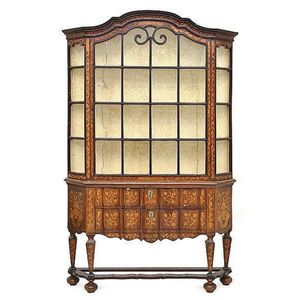Dutch Walnut Marquetry Vitrine with Astragal Glazing
You must be a subscriber, and be logged in to view price and dealer details.
Subscribe Now to view actual auction price for this item
When you subscribe, you have the option of setting the currency in which to display prices to $Au, $US, $NZ or Stg.
- Astragal / Glazing Bars - An astragal, bead or glazing bar is the term used to describe the wooden strips that divide the glass in a cabinet into sections. However it can also refer to the narrow beading on a multi-door cabinet or bookcase that covers the gap between the doors, when they are closed. The astragal is usually attached to the inner stile of the left-hand door (or the right hand as you look at it).
- Veneers - Veneers are thin sheets of well-figured timber that are glued under pressure to the surface of a cheaper timber for decorative effect, and then used in the making of carcase furniture.
Early veneers were saw-cut so were relatively thick, (up to 2 mm) but is was realised that saw cutting was wasteful, as timber to the equivilent of the thickness of the saw was lot on each cut.
A more efficient method was devised to slice the timber, either horizontally with a knife, or in a rotary lathe.
Flame veneer, commonly found in mahogany or cedar furniture, is cut from the junction of the branches and main trunk. So-called fiddleback veneers, where the grain is crossed by a series of pronounced darker lines, is usually cut from the outer sections of the tree trunk.
During the 17th and 18th centuries, and in much of the walnut marquetry furniture made during the latter part of the 19th century, the veneer was laid in quarters, each of the same grain, so that one half of the surface was the mirror image of the other.
The use of veneer allows many other decorative effects to be employed, including stringing, feather banding, cross banding, and inlaid decorative panels in the piece. The carcase over which veneer is laid is usually of cheaper timber such as pine, oak or, sometimes in Australia during the first half of the 19th century, red cedar.
The important thing to remember about veneers is that prior to about 1850 they were cut by hand, and were consequently quite thick - ranging up to about 2mm deep.
From the mid-19th century veneers were cut by machines and were almost wafer-thin. This is a critical point when trying to judge the approximate age of veneered furniture. - Marquetry - In marquetry inlay, contrasting woods, and other materials such as ivory, shell and metal are inlaid either as panels or in a single continuous sheet over the surface of the piece. The design may be straightforward, such as a shell pattern or a basket of flowers, or it may be infinitely complex, with swirling tendrils of leaves, flowers and foliage, such as one finds, for example, in the "seaweed" patterns on longcase clocks of the William and Mary and Queen Anne periods.
This item has been included into following indexes:
Visually similar items

A late 19th century Dutch walnut and marquetry astragal glazed vitrine, with an arched cornice above a glazed panel door and canted glazed sides, with two serpentine fronted doors, square baluster supports and cross-stretchers, 134.5 x 210 x 26 cm Provenan

An oak Jacobean style dresser, English 19th century. 216 cm high, 135 cm wide and 47 cm deep. (With a separate marble top for the dresser base)

An 18th century walnut yew and oyster veneered chest on stand

A mahogany William IV secretaire bookcase, circa 1840, with a shaped pediment and two astragal glazed doors in a rounded arch design above an extended base with a faux drawer/fall front opening to a writing plane and an arrangement of drawers and partition
